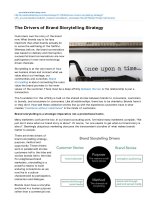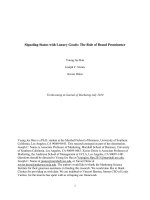The Drivers of Brand Storytelling Strategy
Bạn đang xem bản rút gọn của tài liệu. Xem và tải ngay bản đầy đủ của tài liệu tại đây (93.25 KB, 2 trang )
so cialm ediat o day.co m
/>utm_so urce=feedburner&utm_medium=email&utm_campaign=So cial+Media+Today+(all+po sts)
The Drivers of Brand Storytelling Strategy
Customers own the story of the brand
now. What brands say is f ar less
important than what brands actually do
to serve the well being of the f aithf ul.
Whereas bef ore, the brand conversation
was based on delivery and interruption,
successf ul brand conversations are now
participatory in ever more technology
driven channels.
Storytelling is at the very heart of how
we humans share and connect what we
value about our heritage, our
communities and ourselves. Brand
storytelling is about connecting the outer
value the brand provides to the inner
values of the customer. T here must be a deep af f inity between the two or the relationship is just a
transaction.
The f oundation f or this af f inity is built on the shared stories between brands to consumers, customers
to brands, and consumers to consumers. Like all relationships, there has to be chemistry. Brands have it
or they don’t. How well these collective stories line up with the experience customers have is what
creates “insistence without substitutes” in the minds of customers.
Brand storytelling is a strategic imperative not a promotional tactic.
Many marketers conf use the two. In our brand consulting work, I’ve heard many marketers complain, “We
just don’t know what our brand story is about”. Or worse, “no one seems to get what our brand story is
about”. Seemingly ubiquitous marketing obscures the transcendent storyline of what makes brands
matter to people.
There are three drivers of
brand storytelling strategy -
purpose, method and
opportunity. T hese drivers
work in parallel with stories
customers tell to the tribe and
stories brands tell to the tribe.
For enlightened brand
marketers, storytelling is a
powerf ul means to build
enduring connections as we
now live in a culture
characterized by participation,
interaction and dialogue.
Brands must have a storyline
anchored in a human purpose
rather than a commercial one.
Let’s explore how these
drivers work f rom both the
brand and the customer
perspective:
Purpose
The most basic purpose or
reason f or brands to tell their
story is usually to create or
reinf orce the brand’s positioning and competitive advantage. For customers, the motivation or purpose
to tell brand stories comes f rom a desire to share ideas and experiences as an af icionado of the brands
core purpose. In other words the strategic purpose in the brand story is based in resonance and
relevance.
Met hod
Of course brands have a multitude of methods and media channels to tell their story. T he audience now
is hyper-f ragmented and the method f or storytelling is less about media and more about real
engagement. Customers too, have more methods available through social media channels to share their
brand stories. What this means is the brand’s story is now a shared experience, with both brand and
customer contributing to each other in a more real and meaningf ul manner.
Opportunit y
The opportunity f or brands to tell stories are varied and diverse. Brand storytelling creates awareness to
product innovations and important events on one hand, to more dif f icult issues of public relations
disasters on the other. Brands can be proactive or reactive in this regard. For customers, the opportunity
f or storytelling, by their own initiative, is also driven by good or bad news about a brand experience.
Transparency is the order of the day now. Enlightened marketers now realize they must provide the
venue f or inviting customers to share their experiences and tell their stories.
If you’re a marketer in the process of inventing or transf orming your brand’s positioning, brand
storytelling will be a critical component to building an enduring connection with those of like mind. All
legendary brands have legendary stories told though generations.
Your strategy f or creating a compelling brand story will be driven by your brand’s purpose, the level of
engagement, and the ability to leverage events and circumstances around customer experience.
Sponsored by: The Brand Storytelling Workshop
Connect:
Authored by:
Derrick Daye
I'm the Managing Partner of The Blake Project, a leading brand consultancy. We help small
and large growth oriented companies design, manage and build brands that drive revenue
through dif f erentiated customer experiences. Ask me how: 813-842-2260.
See complete profile
Would you like to contribute to this site? Get started »









